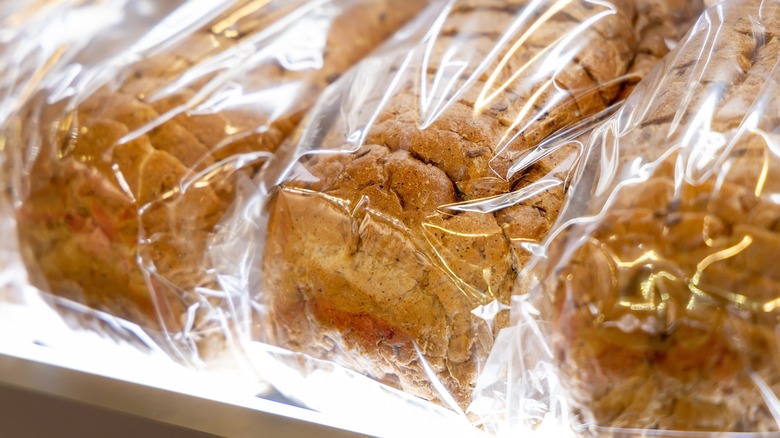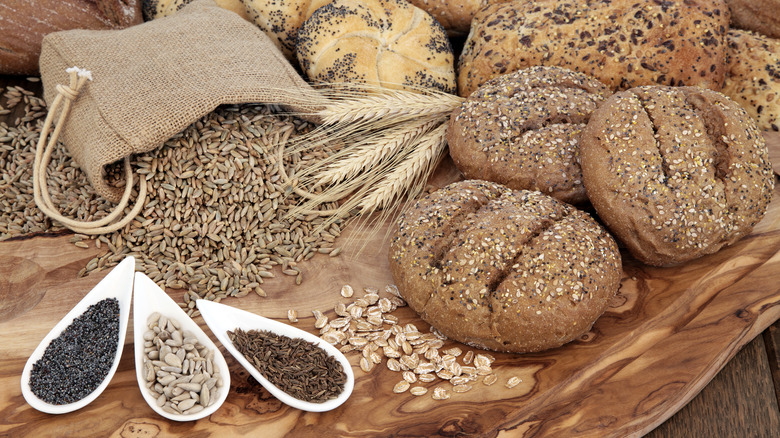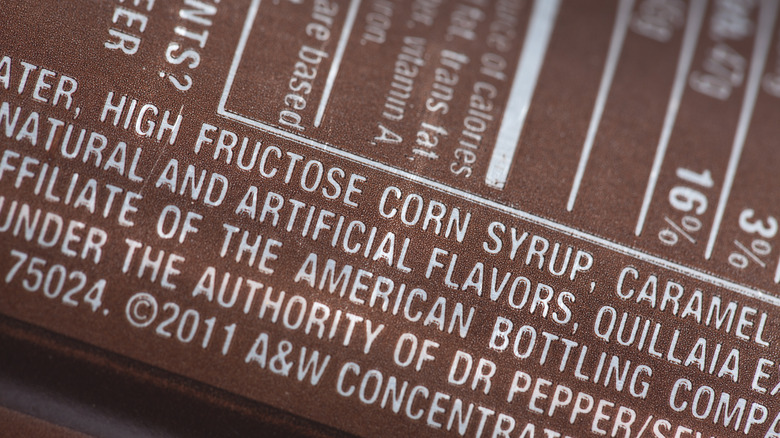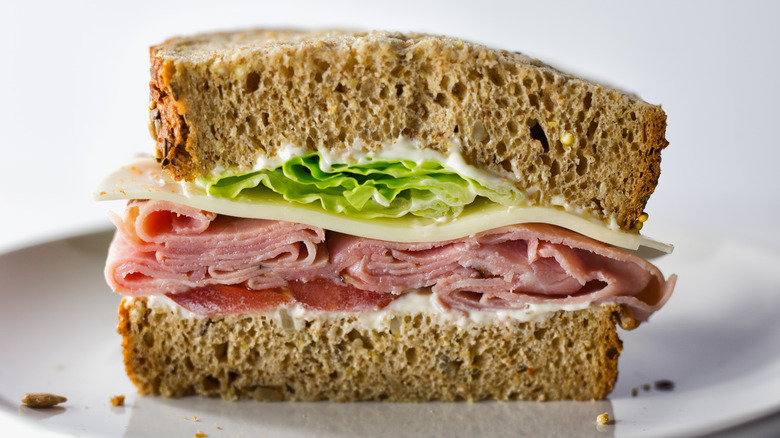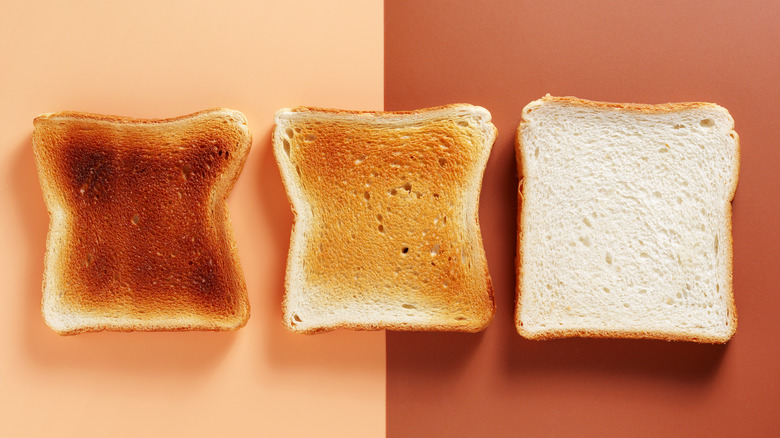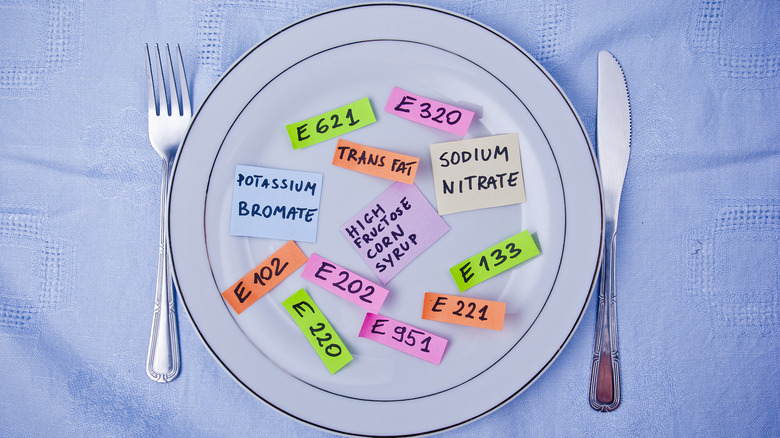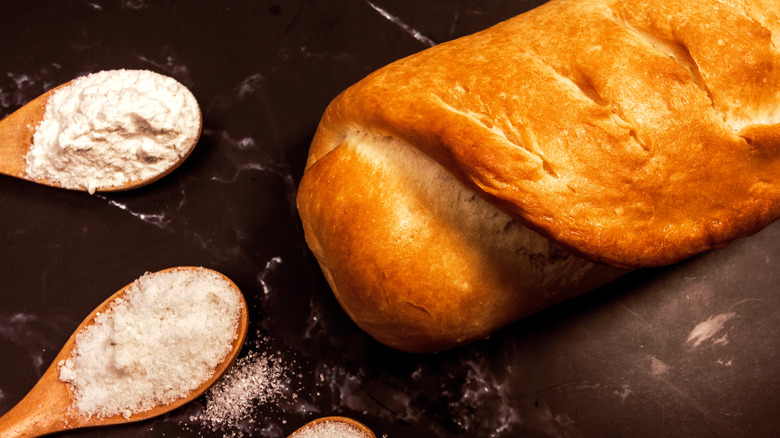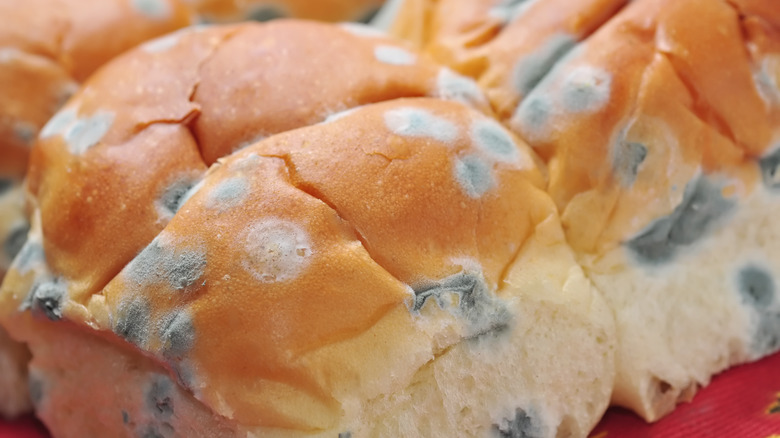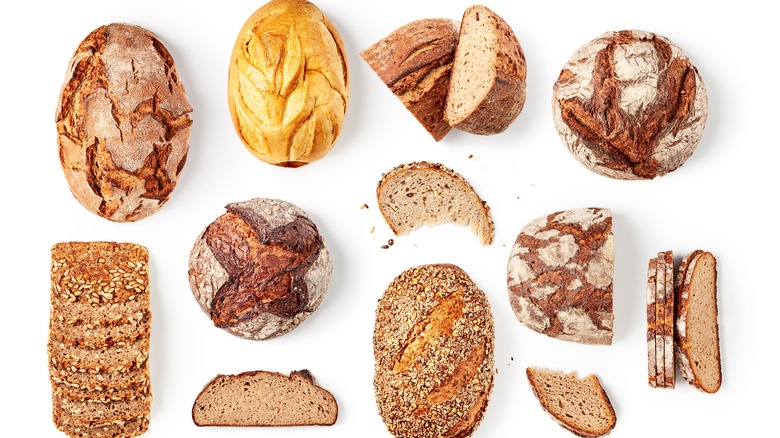Experts Reveal 9 Red Flags To Look For When Buying Bread At The Store
Bread is neither your best friend nor your worst enemy. It's a carbohydrate like many others and consuming it in excess can impact your health, just like any other food. However, choosing the right loaf of bread for your dietary requirements can help maintain your health and become a sustainable meal option.
Highly-processed breads like white or potato varieties can be a larger source of calories and simple carbs, so some of the unhealthiest store-bought breads you can buy are best consumed infrequently. Healthier options include whole grain breads, which are often a good source of essential vitamins and are frequently rich in protein and fiber. These include whole wheat, oat, flax, and sprouted grain breads. Still there are components in bread like gluten, which many people face an intolerance to, so they need to opt for gluten-free breads.
With so many options available in stores, it can quickly become confusing when selecting the right bread. Mashed reached out to experts in the health and wellness field to get their insight on the red flags that make store-bought bread unhealthy. Our panel included Dr. Kevin Huffman, bariatric physician, nutrition specialist, and CEO of Ambari Nutrition, Dr. Aaron Erez, Institute of Functional Medicine practitioner and doctor of osteopathy, and Dr. James Hook, wellness professional and MD at Neurogan Health. Below, you'll find what they had to say about navigating the bread aisle with confidence and making informed decisions about what's in your loaf.
1. It isn't made with whole grains
Before it makes its way to your plate, all bread undergoes processing. In white bread, Huffman tells us that what starts out as a whole grain comprising three parts (bran, germ, and endosperm) gets stripped down to remove its nutritious outer coating and leaves a starchy, carb-dense concentrate behind. White bread is a common choice at the grocery store. However, there are much healthier options out there to start your day.
Take whole grain bread, which keeps the grain kernel intact and can be made from whole wheat, oat, barley, or rye, all of which can possess many nutritional benefits. On navigating the bread aisle, Hook says, ”When bread shopping, rather opt for whole grain or oat bread. They are the perfect nutrient boost as they are packed with vitamins and minerals making them a much healthier choice.”
Ideally, whole grains should be the first ingredient listed on the packaging, and specifically with the word ”whole” appearing before the flour name, like whole wheat flour instead of wheat flour. This difference in labeling can determine whether you get a nutrient-rich loaf or a watered-down version. Another thing to look out for is the 100% whole grain stamp on the packaging, an easy-to-identify label issued by the Whole Grains Council which helps consumers pick out bread with a full or half serving of whole grains.
2. It has a long list of ingredients
A long lineup of ingredients should only belong on your pre-Thanksgiving grocery list — not your bread. Experts say the shorter an ingredients list, the more likely you're buying bread that isn't chock-full of preservatives and processed ingredients. ”Be cautious of breads with a long list of additives and preservatives. These can often reduce the nutritional value [of bread] and may contribute to health issues such as inflammation,” says Erez. He adds that consumers should consider IFM's NOVA classification while choosing bread, which groups foods into different processed states. "Just as ultra-processed salads lose nutrients," he says, "so do ultra-processed breads.”
These preservatives include calcium propionate, a food additive generally considered safe for consumption, but the results of a clinical trial published in 2002 in the Journal of Paediatrics and Child Health suggested it caused sleep and attention disturbances in children when consumed daily in bread. Another ingredient to watch out for is potassium bromate, which improves the elasticity of dough and gives bread its texture, and has been linked to cancer-causing effects after prolonged regular consumption, as per a 2023 study published in Heliyon. The ingredient has been banned in China, Brazil, Canada, and the European Union, but is still used in the U.S. in packaged breads and is sometimes listed as only as bromate on labels. Other common preservatives in bread include sodium benzoate, which has been cautiously linked to inflammation, cancer, and ADHD when consumed in excess (via Healthline).
3. It isn't a good source of fiber
The most common misconception regarding bread is that it's unhealthy and not good for a balanced diet. Hook claims simply cutting bread out but still maintaining an imbalance of calories and eating foods with low nutritional value will lead to weight gain and other adverse health outcomes. He suggests eating whole grain bread that's rich in fiber, and to opt for a variety which lists at least 2 grams of dietary fiber on the label. Meanwhile, Erez suggests purchasing a well-rounded whole grain loaf with plenty of fiber (3 to 5 grams per slice). This information corresponds to numbers found on the USDA's Food Data Central database, as a 0.5-inch or 46 gram slice of whole grain bread should have 4 grams of dietary fiber.
White bread has less than one gram of fiber per slice, as the process of refining the grain strips away the fiber-rich bran. However, even breads widely considered to be healthy, like sourdough, aren't necessarily rich in fiber, as a small slice contains just 1 gram. And consuming plenty of fiber isn't just about improving gut health. A diet rich in fiber also lowers the risk of heart disease, helps regulate your blood sugar, and streamlines digestion (via Healthline). Who knew eating whole grain bread could help to do all that?
4. The protein content per slice is too low
When scouring grocery stores for healthy meal options, did you know that bread can fulfill some of your essential protein requirements? According to the Mayo Clinic Health System, protein should make up 10-35% of your daily calories, so someone working with a 2,000-calorie diet would need 150-175 grams of protein a day. A slice of whole grain bread like whole wheat sourdough, 100% whole wheat, or sprouted grain contains approximately 4 grams of protein per slice, so eating two slices can be a good source of this essential nutrient.
However, the protein ratio can depend on the bread brands, as sprouted grain bread like Food For Life's Ezekiel is an even more rich source of protein. Huffman and Erez recommend including this particular brand in your diet for the health benefits associated with sprouted grains, plus the 5 grams of protein present per slice in its 4:9 Sprouted Whole Grain bread and its Flax Sprouted Whole Grain bread.
With benefits like helping retain muscle and improving bone health, studies show that a protein-rich diet also lowers blood glucose levels in persons with type 2 diabetes, and improves overall blood sugar levels (via American Journal of Clinical Nutrition). So, if you're looking to incorporate more protein-rich foods into your diet, the right whole wheat bread can give you a great start. Ideally, avoid white, wheat, multigrain, or any bread made with refined or enriched flours, as they won't be a solid protein source.
5. It's plain white bread
White bread is made from a processing technique that removes the fiber-dense bran and the nutrient-rich germ of the original grain of wheat, leaving behind the endosperm. According to Huffman, that is ”a concentrated source of starchy carbohydrates that are rapidly digested into blood glucose and can provoke a surge in blood glucose levels." The nutrient profile of white bread is also unimpressive, given that it's high in calories and carbs and a poor source of protein, fiber, and a variety of other vitamins and minerals. These are just some of the reasons why you should never buy white bread; however, given how it's still around on the shelves, it's no surprise that many consumers still believe white bread is superior in taste to its whole grain counterparts.
"White bread is not all bad," says Hook. "It depends on the ingredients used; if you prefer white bread then choose an option that is made from whole wheat.” The notion of whole wheat white bread didn't sit well with all of us at first, much like the concept of mint chocolate ice cream (sorry mint choco lovers). But this bread is very much a thing and is made from an albino whole wheat grain that has a lighter color than wheat and bears the same nutrients as whole wheat bread. So, even if you're still a white bread enthusiast, you can conceivably make your way to a healthier loaf with this unique variety.
6. It has additives like high fructose corn syrup
Fresh bread from either the kitchen or your local bakery isn't readily available to everyone, meaning many turned to packaged bread. To that end, Huffman argued that the occasional preservative in your food is fine and can keep it fresh for a few days. But he and others maintain that there shouldn't be excess synthetic additives in bread. These can include sweeteners, artificial colors, and flavors, which are intended to make bread more palatable.
What exactly are we talking about here. ”Skip anything with high-fructose corn syrup, hydrogenated oils, and excessive sodium," says Erez. "Minimal ingredients lists without artificial additives are your best bet.” That's largely because high fructose corn syrup is classified as an added sugar, since it doesn't come from a natural source, and has been proven to risk health by causing obesity, fatty liver disease, diabetes, and other health problems (via Healthline). Likewise, hydrogenated oils are usually found in packaged foods as trans fat, and their consumption can negatively affect heart health.
Although sweeteners are easy to identify on the label, trans fat is trickier. The FDA states companies can claim a food is free of trans fats if it contains 0.5 grams or less per serving. In this case, familiarizing yourself with the label is important, as ingredients like ”hydrogenated soybean oil” or ”partially hydrogenated vegetable oil” can help you determine if the bread is a source of trans fat, though the amount may be relatively small.
7. It lacks essential vitamins and minerals
Although bread isn't commonly consumed for its vitamin and mineral components, certain types of bread are rich in micronutrients that are worth consideration. Manufacturers will often make breads with flour that has been enriched with iron, riboflavin, thiamin, and selenium to increase the product's nutritional value. Erez recommends consuming bread with minerals like manganese and selenium present to improve the health benefits you can derive from a loaf.
Huffman suggests eating breads that have been made from whole grains as they will be relatively rich in vitamins and minerals such as B vitamins, iron, and magnesium, all of which can be essential to maintaining your overall health. He advises on another type of bread you aren't eating but should be: one that's been made from sprouted grains. This variety has higher levels of certain nutrients and potentially healthy antioxidants, such as vitamins C and E and beta-carotene, which are concentrated due to the sprouting process that makes some nutrients more bioavailable (meaning your body can digest them more easily, as per Harvard Medical School).
Other micronutrients often present in bread include thiamin, folate, niacin, and riboflavin, with higher concentrations in whole wheat and sourdough breads than most varieties of white bread. At the end of the day, it's unlikely that you'll find a loaf with all these nutrients present, but aim for one which lists the majority of them on the packaging.
8. It has elevated sodium and sugars
If a slice of bread is high in sugar, even consuming a standard serving of two slices can spike your blood glucose level, which raises your glycemic index (GI). The GI value measures how much certain foods will increase your blood sugar, with both whole grain and white bread falling on the higher end (via Healthline). However, this doesn't mean you must omit bread from your diet completely, but shifting to a low GI diet is a good idea, especially for those who are at a risk for type 2 diabetes.
Huffman suggests that you pair your sandwich with breads that have a lower GI, like whole wheat, rye, or sprouted grain. These, he says, can help keep you feeling energized and fuller for longer. Many whole wheat breads aren't low GI, as they possess up to 4 grams of total sugars per slice, but they can still be part of a healthy diet when consumed in moderation. Of course, all of those numbers can vary from brand to brand, so it's a smart move to carefully read the nutritional information on the package.
Another hallmark of an unhealthy bread is its sodium content. Elevated sodium levels in bread can raise your blood pressure, which puts a strain on your heart health over time. Ideally, there should be less than 200 milligrams of sodium per slice in your bread, according to Erez, with the USDA suggesting 144 milligrams for an average 32-gram slice.
9. It's overly soft and spongy
At first glance, bread can't rightfully be classified as healthy or unhealthy, but the packaging can reveal if it's safe to eat. Hook emphasizes going for fresh bread from the bakery, and in case of store-bought bread, to inspect the loaf before buying to ensure there's no mold or visibly damaged packaging. Oftentimes bread can get squashed during delivery and handling, and if it's been on the shelves for too long, spoilage may occur. Picking the best bread from the grocery store involves buying from a trusted store, noting the expiration date, and the color of the twist tie to ensure you get the freshest loaf (that last feature is typically linked to the day of the week the bread was prepared).
If the bread has gone moldy, you'll notice fuzzy, colored patches on the slices. As tempting as it might be to cut off the moldy bits and enjoy the remaining bread, the USDA advises against this, recommending consumers to discard the entire loaf when mold develops. Bread is porous, meaning it can get contaminated below the surface once mold forms.
Fresh bread without any preservatives lasts up to four days on the shelf, while packaged breads containing preservatives last longer. To prevent mold from growing on your loaf, store it in a clean, dry place, and freeze it for lasting freshness. Otherwise, you're prone to fall for the biggest mistakes in storing bread, which can ruin a perfectly good loaf.
What are bread green flags?
A loaf of bread free from red flags should ideally be of the whole grain variety (like whole wheat, rye, oat, or barley), as well as a good source of fiber and protein, enriched with vitamins and minerals, and low in added sugars, sodium, and preservatives. This information aligns with the USDA's Dietary Guidelines for Americans, which recommend that half of your daily grain intake should comprise whole grains.
Huffman advises consumers to read labels consciously, opting for breads that fulfill their specific dietary needs. He adds that brands like Ezekiel bread, Nature's Path organic bread, and Silver Hills Bakery make nutritious loaves that fulfill most dietary requirements. In fact, a ranking of whole grain bread brands revealed Ezekiel to be one of the top whole grain bread brands, according to customers.
According to Hook, the key is to pay attention to the label. He says, ”Take a close look at the ingredients and ensure that the first ingredient is some type of whole grain, then look for the fiber content, ensure that there are at least 2 grams of fiber per slice, and look for the sodium, sugar, and saturated fat information. Preferably you do not want to purchase any breads that are overloaded with these.”
